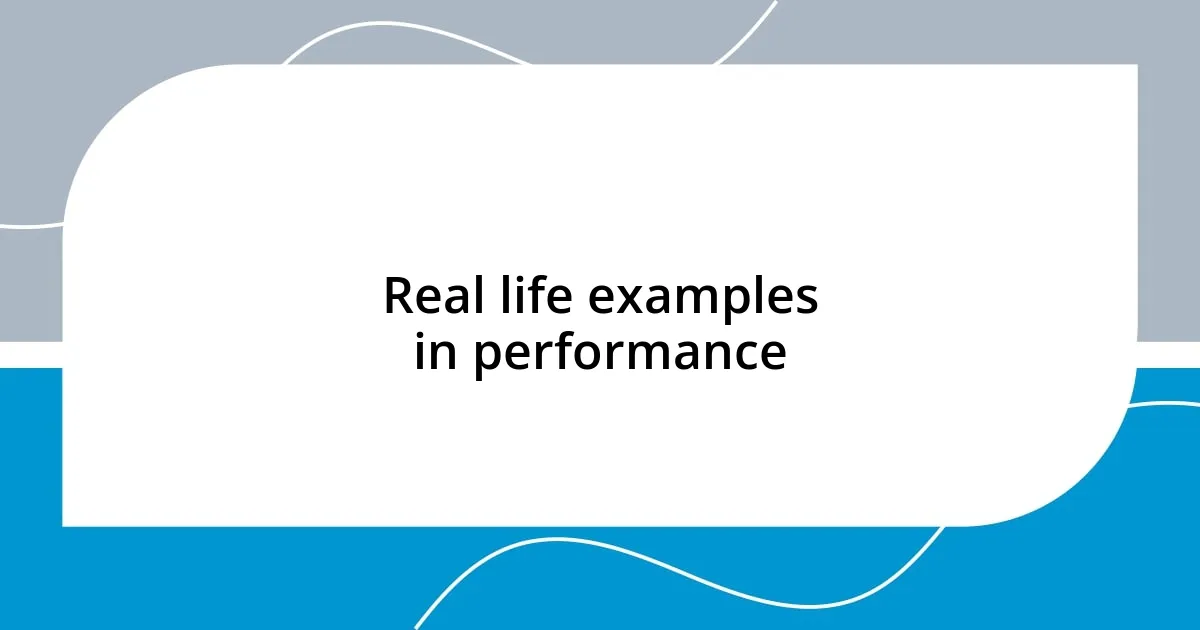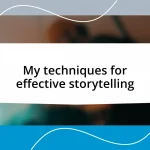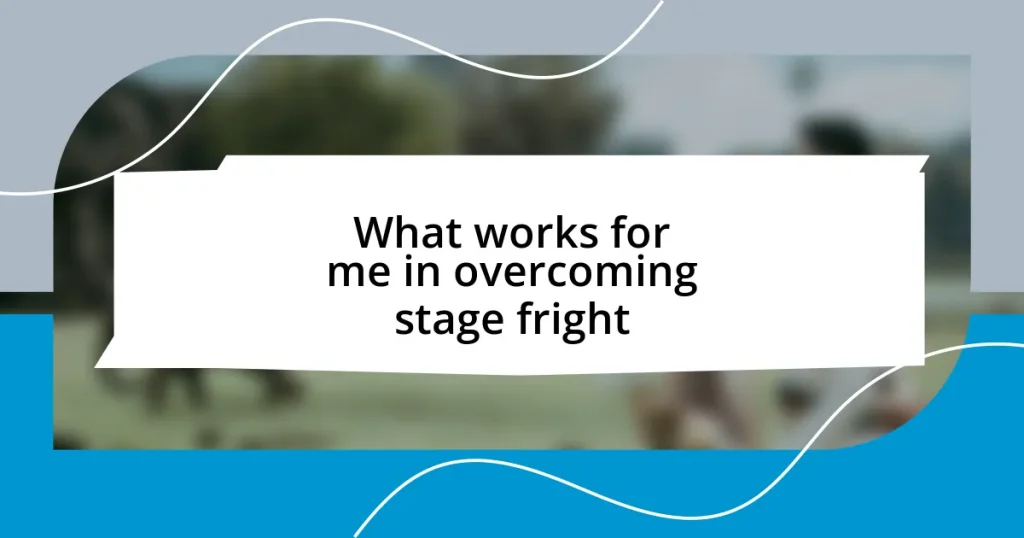Key takeaways:
- Emotional connectivity transforms performances by creating genuine connections between performers and audiences, enhancing engagement and memorability.
- Identifying emotional triggers, such as storytelling and non-verbal cues, fosters deeper responses and resonates with shared human experiences.
- Techniques like personal storytelling and active listening in rehearsals improve emotional bonds, resulting in more impactful performances.
- Post-performance feedback and open discussions with audiences provide valuable insights for sustainable improvement and deeper emotional connections.

Understanding emotional connectivity
Emotional connectivity in performance is about forging a genuine connection between the audience and the performer. I remember attending a live concert where the artist shared a personal story before playing a song. Suddenly, the atmosphere changed; we felt woven into their narrative. Isn’t it intriguing how sharing a moment of vulnerability can transform a distant performance into a shared experience?
When I think about emotional connectivity, I also reflect on how performers can tap into the emotions of their audience. Have you ever found yourself moved to tears or laughter during a performance? That’s the power of emotional resonance. It’s not just about delivering lines or hitting the right notes; it’s about creating a space where the audience feels seen and heard.
I’ve often experienced how powerful emotions can flow in unexpected directions. During a theater production, I felt an overwhelming wave of sadness during a pivotal scene. It struck me that this connection was crafted through the performers’ sincere expressions and relatable themes. How can we explore our own emotional landscapes and share them in a way that invites others in? Emotional connectivity invites us to open that door, creating an intimate dialogue not just between the stage and the audience, but among everyone present.

The impact on performance outcomes
Emotional connectivity profoundly influences performance outcomes. I recall a time at an improv show when the performers connected with the audience through humor stemming from shared experiences. The laughter was infectious. As they played off the crowd’s reactions, the entire energy of the room shifted, making the performance not just entertaining, but an exhilarating moment of collective joy. This kind of engagement elevates performances, transforming them into memorable experiences.
The effects of emotional connectivity on performance outcomes can be summarized in a few key points:
- Enhanced Engagement: When performers establish a genuine emotional link, audience members become more involved.
- Greater Memorability: Performances that evoke strong emotions tend to be remembered long after they end.
- Increased Empathy: Emotional storytelling fosters understanding, making audiences more empathetic toward the performer’s experiences.
- Stronger Relationships: Building emotional connections encourages loyalty between performers and their audience, leading to repeat attendances.
- Improved Performance: When performers feel the audience’s energy, it often elevates their own performance, creating a powerful feedback loop.
In my view, this deep emotional engagement is the secret ingredient that can turn an ordinary performance into something truly extraordinary.

Identifying emotional triggers
Identifying emotional triggers is essential for creating meaningful connections during a performance. I once had the opportunity to attend a poetry reading where the poet’s exploration of loss resonated deeply with my own experiences. It made me realize that emotional triggers are often rooted in shared human experiences, such as love, grief, or joy. By acknowledging these universal themes, performers can tap into sentiments that evoke a strong response from their audience.
I find it fascinating how certain words, visuals, or even sounds can act as catalysts for emotional responses. For instance, during a dance performance, a sudden change in music can evoke nostalgia or excitement, setting the mood for what’s to come. This underscores the importance of identifying these triggers in themselves and their audience. How can performers adapt their delivery to align with these emotional touchpoints? It’s about tuning into both personal emotions and audience reactions.
Moreover, emotional triggers aren’t always overt. Sometimes, they lie in subtle cues, like a fleeting expression on an actor’s face or the choice of lighting in a scene. One unforgettable experience I had was watching a film where the dimming lights conveyed an impending sense of doom. Even before anything happened, I felt the tension rising. Recognizing these nuanced cues can significantly enhance a performer’s ability to create emotional resonance, inviting the audience to join them on a deeper level.
| Emotional Trigger | Potential Audience Response |
|---|---|
| Storytelling | Empathy and Relatability |
| Visual Imagery | Nostalgia or Awe |
| Music Changes | Excitement or Tension |
| Body Language | Identification with Performer |

Techniques to enhance emotional bonds
Creating emotional bonds during performances requires intentional techniques that resonate deeply with audiences. One method I’ve found effective is storytelling that weaves in personal experiences. For instance, while leading a local theatre workshop, I encouraged participants to share their own stories when portraying characters. The result was profound; those who connected their narratives to their performances established stronger emotional ties with the audience, making each scene more impactful. This technique highlights the importance of authenticity—how can we expect the audience to feel anything if we aren’t genuinely connecting to the material ourselves?
Another approach that enhances these bonds is the use of music, which I’ve seen transform the atmosphere entirely. During a community play I was involved in, we played a powerful soundtrack that complemented the emotional arc of the story. Each note seemed to echo the characters’ struggles and triumphs, prompting the audience to feel their joys and sorrows. It was interesting to observe how the right music could elevate our performances, pulling the audience along for the emotional ride. Have you ever noticed how a particular song can turn a simple moment into something unforgettable?
In addition, non-verbal communication plays a pivotal role in establishing emotional connections, and I’ve experienced this firsthand during a dance performance. The performers used their movements to convey raw emotions without uttering a single word. I remember feeling chills as one dancer expressed pain through dynamics alone. It’s fascinating how body language can transcend language barriers—what stories can our gestures tell that words may fail to express? By being aware of how we physically present ourselves, we can invite audiences into our emotional world and create an unforgettable bond.

Measuring emotional connectivity
Measuring emotional connectivity in performance can be quite nuanced. I often think of emotional resonance as a spectrum, where certain performances just hit differently. For example, I once watched a small theater group tackle complex themes of love and loss. Their ability to evoke real tears from the audience made me realize that capturing emotional connectivity is less about grand gestures and more about genuine interactions and responses. How do we quantify that connection?
One approach I use involves audience feedback, often through informal discussions after a show. I remember chatting with a friend who had experienced a particularly heart-wrenching scene. His reflections on why he felt such a strong pull made me see how emotional connectivity could manifest in different ways—ranging from silence to laughter, or even a collective gasp. I’ve learned that observing these reactions is just as crucial as the performance itself. It’s almost like gathering raw data, but it’s filled with emotions that no numbers can truly capture.
Another method worth considering is the use of technology to gauge emotional responses. In a recent performance art piece, the creators incorporated wearable devices that tracked audience heart rates. Seeing the spikes in real-time as the narrative unfolded was enlightening. It prompted me to ask, does technology enhance our understanding of emotional connectivity, or does it create a barrier? I’ve found that mixing subjective interpretations with objective data can provide a more holistic view of how well emotional sentiments are conveyed during performances. It sparks an ongoing dialogue about the essence of emotional connectivity and how we, as performers and audiences alike, can better measure it.

Real life examples in performance
One striking example of emotional connectivity in performance took place during a poetry slam I attended. A poet shared a deeply personal story about overcoming grief, which left the audience in a collective silence. I felt my heart race as the weight of their words settled in. The rawness of their vulnerability was palpable, making me wonder—how often do we allow ourselves to bare our souls on stage?
In a different setting, I once participated in a music festival where performers collaborated unexpectedly. A group of artists blended genres spontaneously, creating a spontaneous emotional landscape. The overwhelming joy of their connections sparked an electric energy that radiated throughout the crowd. I remember dancing with strangers, united by the shared experience. Isn’t it fascinating how spontaneous moments can create stronger emotional ties than even the most meticulously planned performances?
Another memorable moment occurred during a community theater production where the cast conducted a post-show talkback session. One audience member, visibly moved, shared how the play resonated with their personal experiences of loss and redemption. Listening to their heartfelt reflections made me realize that performance is a two-way street; it’s not just about conveying emotions, but also about inviting the audience to share their own. Isn’t that the essence of artistry? Creating a space where stories intertwine and hearts connect?

Strategies for sustainable improvement
Creating sustainable improvement in emotional connectivity during performances requires intentional strategies that deepen audience engagement. I recall a time when we organized a workshop for performers where we practiced active listening techniques. This approach not only refined their ability to respond in the moment but also encouraged them to consider the audience’s emotional state, fostering an environment of mutual vulnerability. How often do we invest in developing these relational skills?
Another effective strategy I’ve seen is incorporating storytelling exercises into rehearsals. In one instance, we had actors share personal stories related to their characters’ journeys. This exercise helped them connect authentically, translating to more powerful performances that resonated emotionally with the audience. It strikes me that the more we tap into our own experiences, the more genuine our portrayals become. Isn’t it fascinating how a simple story can transform our understanding of emotional expression?
Lastly, I’ve learned that creating a feedback loop after performances can be incredibly valuable. For example, during a recent play, we encouraged open discussions with the audience about their emotional experiences. This not only provided us insights for improvement but also made attendees feel seen and heard in a deeper context. It’s a reminder that our growth as performers heavily relies on the audience’s perspective. How can we continue to foster this dialogue for everyone involved?














